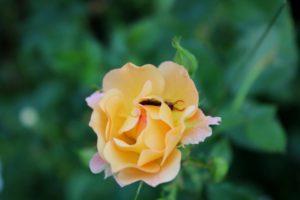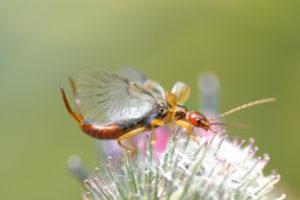What an earwig looks like: a harmful insect - an assistant to gardeners
The earwig insect belongs to the order Leatheroptera. Omnivorous individuals live in rural areas and can damage crops. However, they cannot be called unambiguously pests, since they also bring benefits.
Content
Earwigs: photo
Description of the earwig
Name: earwig
Latin:Forficula auriculariaClass: Insects - Insecta
Squad: Leatheroptera - Dermaptera
Family: True earwigs - Forficulidae
 | Habitats: | garden and vegetable garden, woods |
 | Dangerous for: | plants, flowers, aphids |
 | Means of destruction: | attraction of enemies, prevention |
The size of the insect varies from 12 to 17 mm. The males are larger than the females. The body is elongated and flattened. The top is brown. Heart-shaped head. Mustache in the form of threads. The length of the antennae is two-thirds of the entire length of the body. The eyes are small.
The forewings are short and have no veins. On the hind wings there are membranes with pronounced veins. During the flight, the vertical position is maintained. The earwig prefers ground transportation. Paws are strong with a gray-yellow tint.
What are churches
There are cerci on the terminal part of the belly. They are similar to tongs or tongs. Churches create a frightening image.
These appendages protect the insect from enemies and help keep prey.
Life cycle
During the year, all stages of development go through. The mating season falls in autumn. The female prepares the place. The female starts digging holes in the damp soil. Wintering takes place in the same place.
In winter, the female lays 30 to 60 eggs. The duration of the incubation period is from 56 to 85 days. Eggs absorb moisture and double in size.
In May, the larvae appear. They are gray-brown in color. Length 4,2 mm. They differ from adults in undeveloped wings, size, color.
During the summer, molting occurs 4 times. Changes in color and cover. By the end of summer, individuals can breed. The best conditions for the formation of larvae and eggs are a warm and humid climate.
Distribution area
The homeland of the insect is Europe, East Asia, North Africa. However, at the present time, the earwig can be found even in Antarctica. The development of the geographical range is increasing day by day.
Scientists have even found them on islands in the Pacific Ocean. In the Russian Federation, a large number lives in the Urals. It was brought to North America in the 20th century.
The European variety belongs to terrestrial organisms. Shows the greatest activity at the minimum fluctuations of daily temperature.
Inhabitation
During the day they hide in dark and damp places. They live in forests, agricultural and suburban areas. In the mating season, females live in an environment where there are many nutrients. They lay and bury their eggs there. They can live on the stems of flowers.
Sleeping individuals withstand cool temperatures. They rarely survive in poorly drained soil, such as clay.
Diet
Insects consume a variety of plant and animal substances. Despite the fact that earwigs are omnivores, they are classified as predators and scavengers. They eat:
- beans;
- beetroot;
- cabbage;
- cucumber;
- lettuce;
- peas;
- potatoes;
- celery;
- jealous;
- tomato;
- fruits;
- flowers;
- aphids;
- spiders;
- larvae;
- ticks;
- insect eggs;
- lichen;
- fungi;
- algae;
- apricot;
- peach;
- plum;
- pear.
Of the natural enemies, ground beetles, beetles, wasps, toads, snakes, and birds can be noted. Earwigs are protected by forceps and glands. The glands repel predators with their unpleasant odor.
Harm from earwigs
Insects gnaw through plants and leave holes in the leaves. The earwig feeds on pulp and stems. Black dots form on the foliage. They can fit in outbuildings with crops and harm them.
Insects crawl into the hive and eat honey and bee bread. They are able to destroy the root system of ornamental and fruit crops. The earwig is dangerous for poppies, asters, dahlias, phloxes. Spoils indoor flowers.
Tangible benefits
Despite the huge amount of harm, insects feed on invertebrates - aphids and spider mites. Thus, they save many crops from pests. They also remove rot by eating overripe or fallen fruits.
The name "earwig" suggests terrible thoughts that human ears suffer. But this is a myth with no evidence. They may bite, but such an injury will cause no more than mild discomfort.
Earwig control methods
With all the benefits of the insect, with a large number of individuals on the site, they need to be disposed of. A few tips for fighting:
- they clean the stale hay, straw, foliage and firewood on the site;
- produce deep digging for the winter;
- set traps;
- for bait put 2 boards with wet rags and leaves;
- pour boiling water over the intended places;
- in the apartment close up all the cracks, eliminate leaks;
- periodically inspect indoor plants;
- lay out sponges soaked in vinegar;
- insecticides are added to baits.
Conclusion
Earwigs are real orderlies in the garden. However, they do more harm than good. When pests appear, they begin to fight them immediately in order to preserve the crop.
Previous

